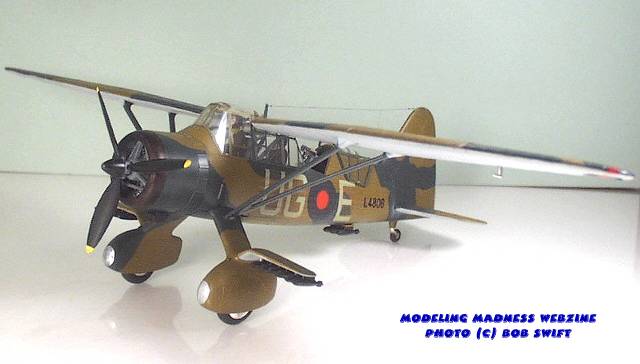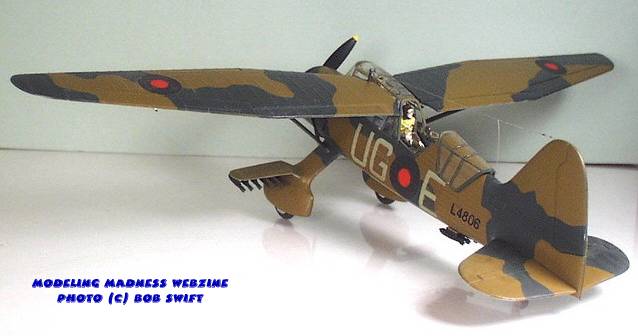
Hawk 1/48 Lysander Mk. II
Decals: For Two Aircraft
Price: $6.95 [way back when]
Overall: A
Review and Photo By: Bob Swift

The Lysander was one of the more unusual looking general purpose aircraft to enter active service on either side during WWII. Initial design work began in 1935 in response to an official Air Ministry specification to replace the obsolete Audax army cooperation aircraft then in squadron service with the RAF. The design embodied many refinements developed through experimentation, over time, relative to the high lift properties of various wing types incorporating devices like leading edge slats, and special trailing edge flaps; all of which was intended to provide positive control in flight at very low ground speeds. In this respect the Lysander was very effective in what came to be known in later years as, "STOL" technology. In Germany, the Fiesler Storch was developed for much the same purpose; getting in and out of cramped places, but the Lysander was a much larger airplane with much more power available than the Storch and designed with offensive action in mind. The Lysander's tailplane could be moved in flight to provide negative insecdence to counteract pitch down of the nose when the slats opened with the flaps extended. In lightly loaded condition, the Lysander could be airborne and clear a fifty foot obstacle in less than 250 yards; it could land in slightly more than 300 yards. A notice hanging in the Royal Observer Corps training center at Oxford read, "There is a difference between a barrage balloon, an aeroplane, and a Lysander; the aeroplane can't stand still in the air - which makes it difficult to identify".
This model represents a Lysander II which was powered by a Bristol Perseus XII, nine cylinder, air cooled, sleeve valve radial engine of 905 hp. Top speed at rated altitude was on the order of 230 mph.
Armament consisted of two Browning .303 machine-guns; one in the upper part of each main wheel spat with 500 rounds for each gun. In the rear cockpit was a free mounted Lewis gun of the same caliber. A total of sixteen, twenty pound GP bombs could be carried beneath the stub wings attached to the landing gear struts, and on a rack under the fuselage just aft of the rear cockpit. Once hostilities were joined, it didn't take long to determine that the Lysander was inadequate for front line offensive operations. By the time of Dunkirk, Lysander loses to all causes exceeded 50%, and those still airworthy were withdrawn to England. The Lysander's unique capabilities rendered it invaluable in other applications; notably, clandestine night operations into, and out of occupied territory. It continued to serve throughout the war in all theaters involving British military activity; many examples still flying in Canada into the 1960's.

This kit was molded in dark green plastic, a bit thicker than today's standards, and is currently unavailable in the general retail market; Hawk Model Co., per se, having disappeared from the modeling scene a number of years ago. It may not be Hawk's last public release, but it is certainly one of the best kits they ever produced. In terms of ingenuity and engineering there are many features equivalent to things being done today by the best of Asian and European manufacturers. Things like the engine cowl flaps which are paper-thin on the trailing edge; a beautifully detailed Bristol radial complete with the triangular front supports; raised rivet detail that is in scale and delicately rendered; separation lines around moveable surfaces that are deeply molded, enhancing the effect that they are moveable control surfaces; crew figures that are loaded with discernible detail; so much so that it would have been a mistake to omit them (cockpits are a bit barren; so putting the crew in helps to fill the space). An instrument panel decal is provided as well as a surface map decal for the chart table in the rear cockpit. The Lewis gun in the rear station is a real gem, complete with spare ammo drums for the weapon. The internal wing support structure is nicely done; surprisingly it is non-loadbearing; which relates to the greenhouse canopy. The canopy is molded in three crystal clear parts; they are much thicker than found today, but necessarily so because the top segment is glued into each wing half then into the main canopy segment. This attachment and two 'V' struts from the wing undersides to points on the landing gear covers are the sole support for the rather large wing. Surprisingly, this arrangement is more robust than it first appears to be. We anticipated that this part of assembly would be the most problematic, with considerable fiddling around getting everything aligned and nailed down before the glue dried on us; what a pleasant surprise when everything clicked into place with a perfect fit all around. Our biggest problem was gluing the sixteen little bombs in place; had to be done in two sessions; skipping every other bomb, then getting the rest the next evening.
Decals were thicker than modern material, but they were nicely printed with excellent color to color register; testing revealed that they wouldn't disintegrate; so we used them. Setting solution didn't affect them very much, but they seemed to go down ok after a little effort. Poly-S paint was used along with MM Burnt Metal metalizer on the exhaust collector ring. We chose to do it in green and mid-stone with grey undersurfaces; our reference shows one somewhere between mid-stone and dark earth which is probably a result of the printing process, but a test of this combination was very pleasing; so, we went with it. The only poorly executed aspect of the model was the landing lights located in the front portion of the wheel spats; there wasn't much that could be done to correct this shortcomming.
This model should have been built many years ago, but like most addicts, I tend to collect so I don't run out, or feel insecure, or something. It was stored away for many years until recently when we took up the hobby again. Now that it is finished I'm glad it wasn't built right after buying it; instead it provided some pleasant evenings of enjoyment in the present.
Copyright ModelingMadness.com. All rights reserved. No reproduction in part or in whole without express permission from the editor.